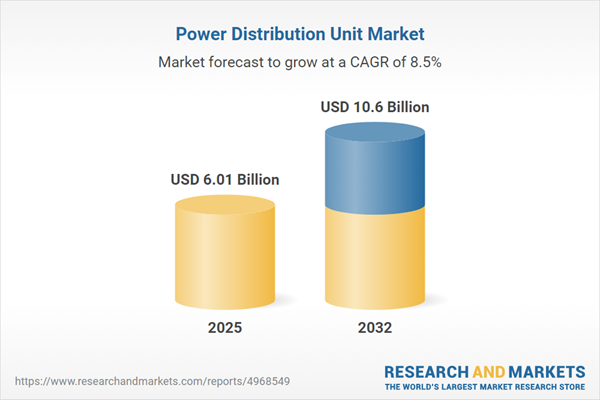Speak directly to the analyst to clarify any post sales queries you may have.
Organizations navigating digital transformation increasingly depend on robust energy management, making effective power distribution unit (PDU) deployment essential to support continuity, compliance, and operational agility across modern infrastructure landscapes.
Market Snapshot: Power Distribution Unit Market
The global power distribution unit market is valued at USD 5.54 billion in 2024 and is projected to reach USD 10.60 billion by 2032, registering a compound annual growth rate (CAGR) of 8.45%. This growth reflects heightened reliance on reliable power delivery in sectors such as financial services, healthcare, government, and IT. The rising adoption of intelligent PDUs supports sophisticated energy management and compliance, while innovation drives the evolution of flexible, highly customizable power solutions. Leading industry stakeholders are prioritizing differentiation to address complex, evolving operational requirements across various global enterprises.
Scope & Segmentation of the Power Distribution Unit Market
- Product Types: Basic and metered PDUs serve core power distribution needs, with metered options enabling real-time power consumption monitoring and enhanced load management in critical environments.
- Phase Options: Single-phase units fulfill standard operational needs, while three-phase models serve larger-scale deployments, such as data centers and industrial facilities demanding higher loads.
- Mounting Styles: Floor, rack, and wall-mounted configurations provide deployment versatility, adapting to unique facility layouts across commercial and technical environments.
- Distribution Capacity: Sub-10Kva models deliver targeted power for specialized applications, and high-capacity PDUs above 20Kva maintain uninterrupted operations in large or mission-critical sites.
- Applications: Integration in commercial, industrial, and residential spaces helps reduce risk where any disruption could impact productivity, data integrity, or safety mandates.
- End Users: PDUs are fundamental for sectors seeking to futureproof operations, namely financial, healthcare, education, government, IT, and telecom, where infrastructure modernization is a strategic priority.
- Regional Coverage: Demand remains strong in the Americas and Europe, particularly in the UK and Germany. Markets in Asia-Pacific, including India, China, Australia, and Singapore, are rapidly expanding, while Nigeria and MEA regions see accelerated uptake due to urbanization and infrastructure investment.
- Leading Companies Covered: Schneider Electric SE, Eaton Corporation plc, Vertiv Holdings Co, Legrand S.A., Delta Electronics, Inc., ABB Ltd, Siemens AG, CyberPower Systems, Inc., Socomec Group, and Belkin International, Inc. drive the integration of new technologies and compliance advancements across industries.
Key Takeaways for Senior Decision-Makers
- Intelligent, digital PDUs provide actionable energy data, equipping enterprises with the tools to manage dispersed or hybrid operations strategically.
- Advanced sensor and analytics integration enables predictive maintenance, reducing risk and helping organizations plan for system upgrades without unplanned downtime.
- Modular PDU architectures simplify scalability, aligning infrastructure investments with evolving regulatory and operational requirements as environments grow more complex.
- Sustainable material adoption supports long-term infrastructure value, helping firms align with their broader ESG and governance goals.
- Selecting suppliers with robust compliance standards reduces procurement risks and helps ensure supply chain stability in fluctuating market environments.
Tariff Impact
Recent tariff adjustments in the United States are prompting enterprises to reconsider procurement strategies for power distribution units. Many organizations are prioritizing domestic and nearshore sourcing to maintain cost efficiency and regulatory compliance while ensuring supply continuity for these essential energy assets.
Methodology & Data Sources
This market study combines direct interviews with facility managers and procurement executives across priority sectors, along with evaluation of technical documentation and relevant regulatory standards. The methodology ensures all insights are grounded in real-world applications and actionable segmentation.
Why This Report Matters
- Enables effective strategic planning by aligning infrastructure investments with compliance and performance objectives.
- Provides insights that support targeted capital allocation for energy management and sustainability priorities.
- Prepares leaders to adapt to market and regulatory changes while building stronger supplier networks for operational continuity.
Conclusion
Flexible power distribution units underpin operational resilience in evolving environments. Strategic deployment and proactive supplier engagement strengthen readiness to address future infrastructure and compliance demands.
Additional Product Information:
- Purchase of this report includes 1 year online access with quarterly updates.
- This report can be updated on request. Please contact our Customer Experience team using the Ask a Question widget on our website.
Table of Contents
3. Executive Summary
4. Market Overview
7. Cumulative Impact of Artificial Intelligence 2025
Companies Mentioned
The companies profiled in this Power Distribution Unit market report include:- Schneider Electric SE
- Eaton Corporation plc
- Vertiv Holdings Co
- Legrand S.A.
- Delta Electronics, Inc.
- ABB Ltd
- Siemens AG
- CyberPower Systems, Inc.
- Socomec Group
- Belkin International, Inc.
Table Information
| Report Attribute | Details |
|---|---|
| No. of Pages | 181 |
| Published | October 2025 |
| Forecast Period | 2025 - 2032 |
| Estimated Market Value ( USD | $ 6.01 Billion |
| Forecasted Market Value ( USD | $ 10.6 Billion |
| Compound Annual Growth Rate | 8.4% |
| Regions Covered | Global |
| No. of Companies Mentioned | 11 |









